YAMAHA WR 250F 2017 Owners Manual
Manufacturer: YAMAHA, Model Year: 2017, Model line: WR 250F, Model: YAMAHA WR 250F 2017Pages: 432, PDF Size: 14.14 MB
Page 251 of 432

CYLINDER HEAD
6-22
EAS2GBB245REMOVING THE CYLINDER HEAD
1. Remove:
• Intake camshaft
• Exhaust camshaft
Refer to “REMOVING THE CAMSHAFT” on
page 6-14.
2. Remove:
• Cylinder head nuts
• Cylinder head bolts
TIP
• Loosen the bolts in the proper sequence as
shown.
• Loosen each bolt 1/2 of a turn at a time. After
fully loosening all the bolts, remove them.
EAS2GBB246CHECKING THE TIMING CHAIN GUIDE (IN-
TAKE SIDE)
1. Check:
• Timing chain guide (intake side)
Damage/wear Replace.
EAS2GBB247CHECKING THE CYLINDER HEAD
1. Eliminate:
• Combustion chamber carbon deposits
TIP
Use a rounded scraper, not a sharp instrument,
in order not to damage or scratch the spark
plug bore threads.2. Check:
• Cylinder head
Damage/scratches Replace.
TIP
When replacing the cylinder head, replace also
the valve.
Refer to “CHECKING THE VALVE SEATS” on
page 6-27.
• Cylinder head coolant passages
Mineral deposits/rust Eliminate.
3. Measure:
• Cylinder head warpage
Out of specification Resurface the cylin-
der head.
▼▼▼▼▼▼▼▼▼▼▼▼▼▼▼▼▼▼▼▼▼▼▼▼▼▼▼▼▼▼▼▼
a. Place a straightedge and a thickness gauge
across the cylinder head.
b. Measure the warpage.
c. If the limit is exceeded, resurface the cylin-
der head as follows.
d. Place a 400–600 grit wet sandpaper on a
surface plate, and resurface the cylinder
head using a figure-eight sanding pattern.
TIP
To ensure an even surface, turn the cylinder
head several times.
▲▲▲▲▲▲▲▲▲▲▲▲▲▲▲▲▲▲▲▲▲▲▲▲▲▲▲▲▲▲▲▲
61
2
35
4 x2 x4FWD
Warpage limit
0.05 mm (0.0020 in)
Page 252 of 432
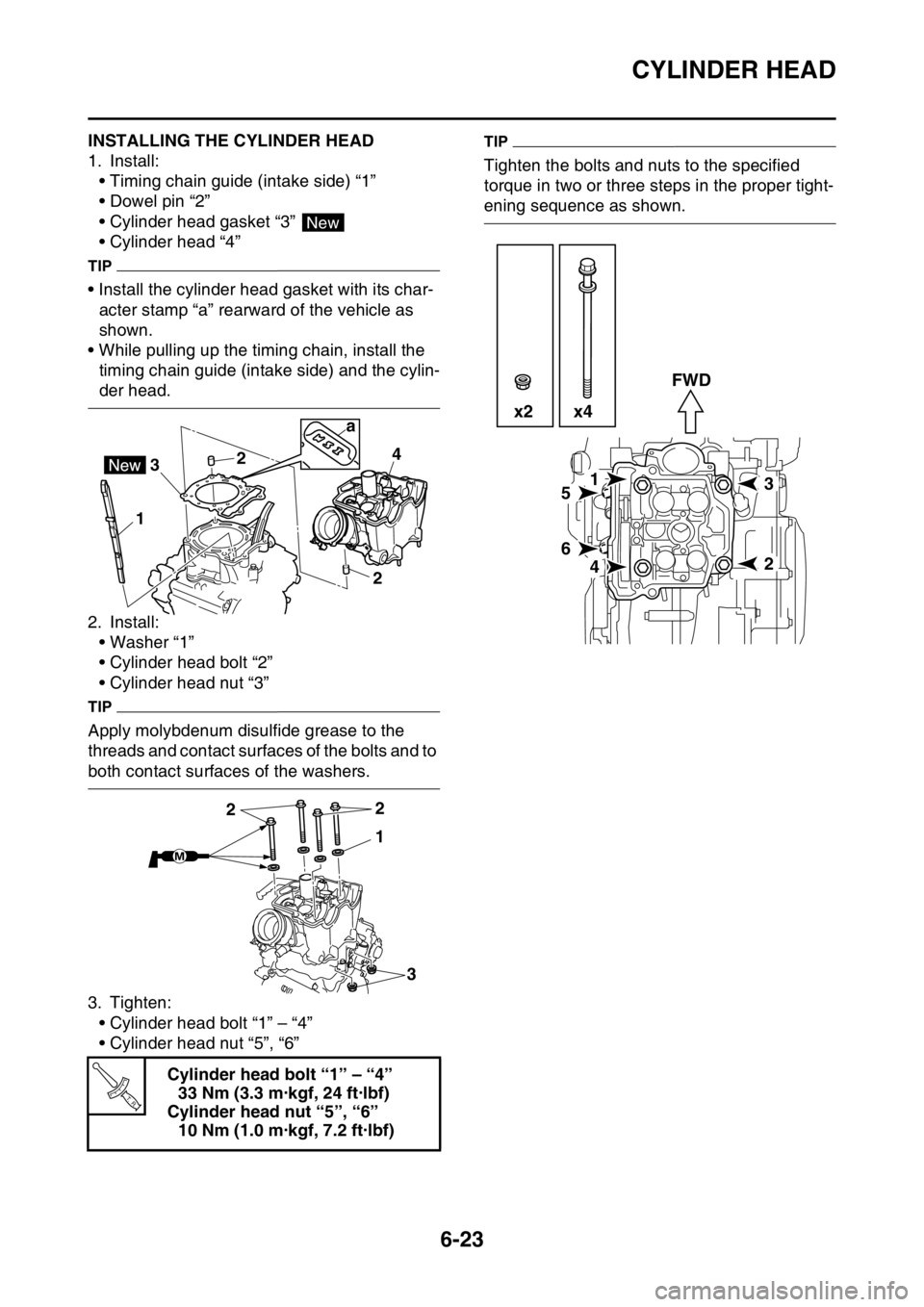
CYLINDER HEAD
6-23
EAS2GBB248INSTALLING THE CYLINDER HEAD
1. Install:
• Timing chain guide (intake side) “1”
• Dowel pin “2”
• Cylinder head gasket “3”
• Cylinder head “4”
TIP
• Install the cylinder head gasket with its char-
acter stamp “a” rearward of the vehicle as
shown.
• While pulling up the timing chain, install the
timing chain guide (intake side) and the cylin-
der head.
2. Install:
• Washer “1”
• Cylinder head bolt “2”
• Cylinder head nut “3”
TIP
Apply molybdenum disulfide grease to the
threads and contact surfaces of the bolts and to
both contact surfaces of the washers.
3. Tighten:
• Cylinder head bolt “1” – “4”
• Cylinder head nut “5”, “6”
TIP
Tighten the bolts and nuts to the specified
torque in two or three steps in the proper tight-
ening sequence as shown.
Cylinder head bolt “1” – “4”
33 Nm (3.3 m·kgf, 24 ft·lbf)
Cylinder head nut “5”, “6”
10 Nm (1.0 m·kgf, 7.2 ft·lbf)
New
12
24
3
a
1
3 22
T R..
15
6
42
3 FWD
x2 x4
Page 253 of 432
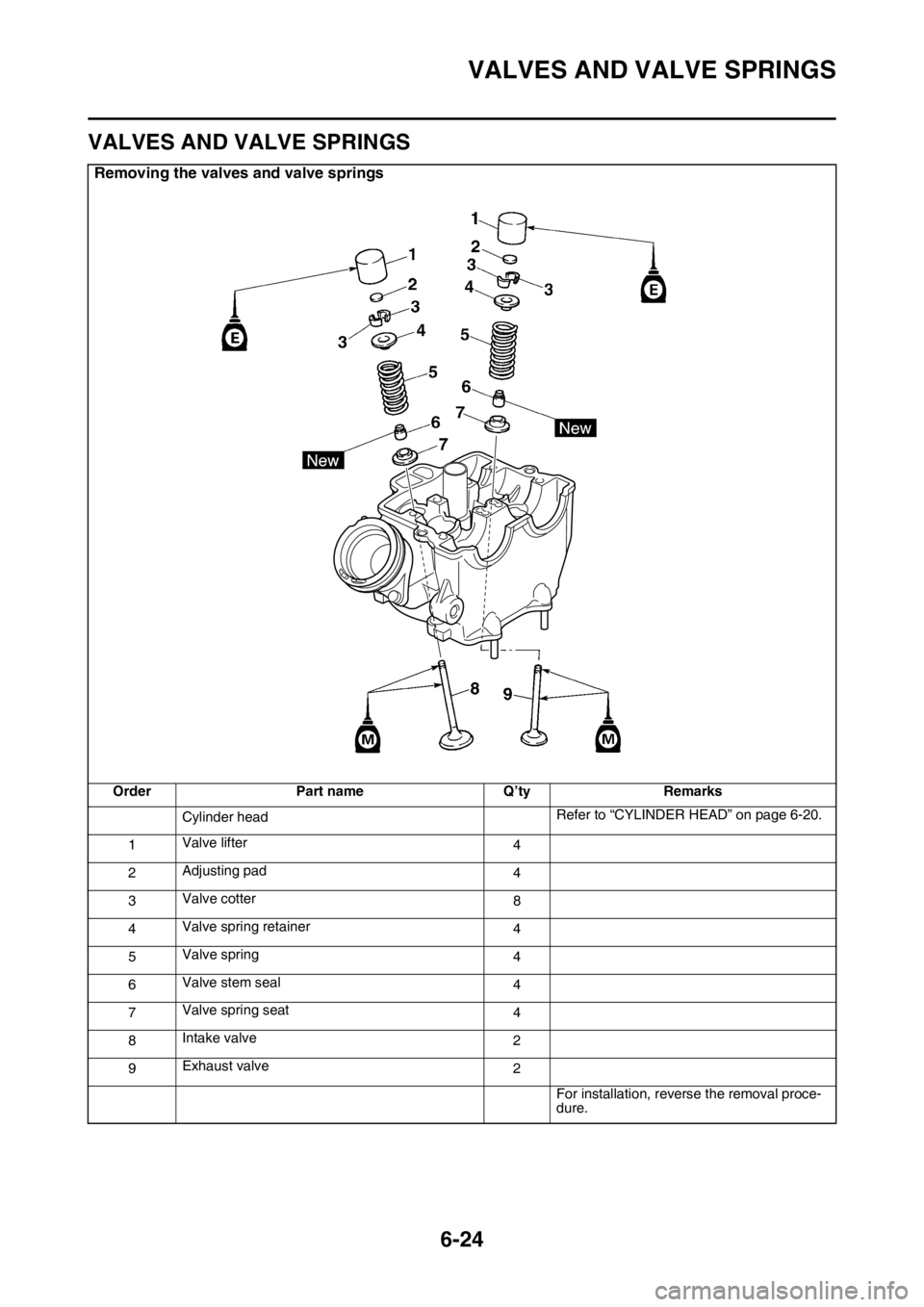
VALVES AND VALVE SPRINGS
6-24
EAS2GBB249
VALVES AND VALVE SPRINGS
Removing the valves and valve springs
Order Part name Q’ty Remarks
Cylinder headRefer to “CYLINDER HEAD” on page 6-20.
1Valve lifter
4
2Adjusting pad
4
3Valve cotter
8
4Valve spring retainer
4
5Valve spring
4
6Valve stem seal
4
7Valve spring seat
4
8Intake valve
2
9Exhaust valve
2
For installation, reverse the removal proce-
dure.
Page 254 of 432
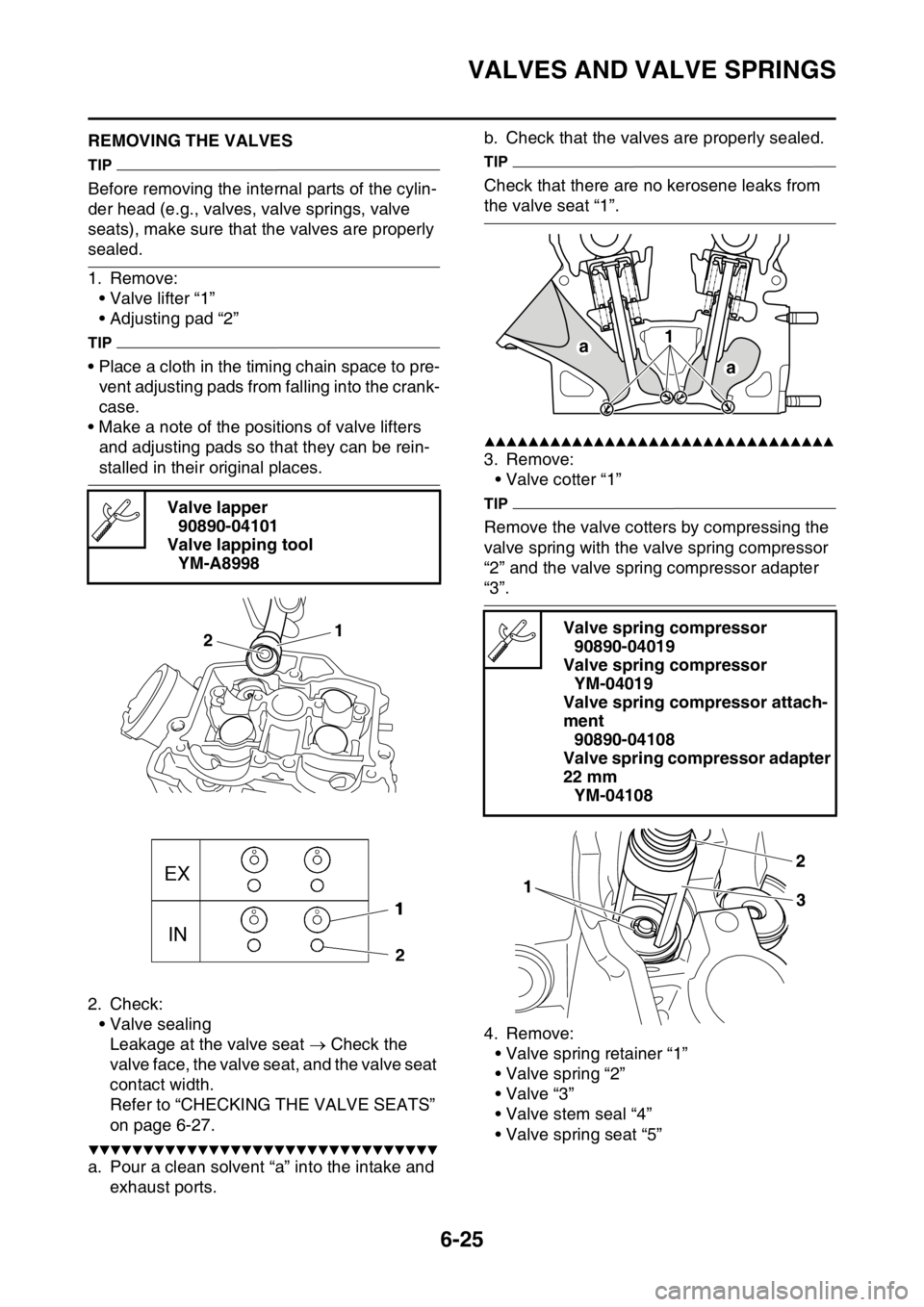
VALVES AND VALVE SPRINGS
6-25
EAS2GBB250REMOVING THE VALVES
TIP
Before removing the internal parts of the cylin-
der head (e.g., valves, valve springs, valve
seats), make sure that the valves are properly
sealed.
1. Remove:
• Valve lifter “1”
• Adjusting pad “2”
TIP
• Place a cloth in the timing chain space to pre-
vent adjusting pads from falling into the crank-
case.
• Make a note of the positions of valve lifters
and adjusting pads so that they can be rein-
stalled in their original places.
2. Check:
• Valve sealing
Leakage at the valve seat Check the
valve face, the valve seat, and the valve seat
contact width.
Refer to “CHECKING THE VALVE SEATS”
on page 6-27.
▼▼▼▼▼▼▼▼▼▼▼▼▼▼▼▼▼▼▼▼▼▼▼▼▼▼▼▼▼▼▼▼
a. Pour a clean solvent “a” into the intake and
exhaust ports.b. Check that the valves are properly sealed.
TIP
Check that there are no kerosene leaks from
the valve seat “1”.
▲▲▲▲▲▲▲▲▲▲▲▲▲▲▲▲▲▲▲▲▲▲▲▲▲▲▲▲▲▲▲▲
3. Remove:
• Valve cotter “1”
TIP
Remove the valve cotters by compressing the
valve spring with the valve spring compressor
“2” and the valve spring compressor adapter
“3”.
4. Remove:
• Valve spring retainer “1”
• Valve spring “2”
•Valve “3”
• Valve stem seal “4”
• Valve spring seat “5” Valve lapper
90890-04101
Valve lapping tool
YM-A8998
1
2Valve spring compressor
90890-04019
Valve spring compressor
YM-04019
Valve spring compressor attach-
ment
90890-04108
Valve spring compressor adapter
22 mm
YM-04108
a1
a
Page 255 of 432
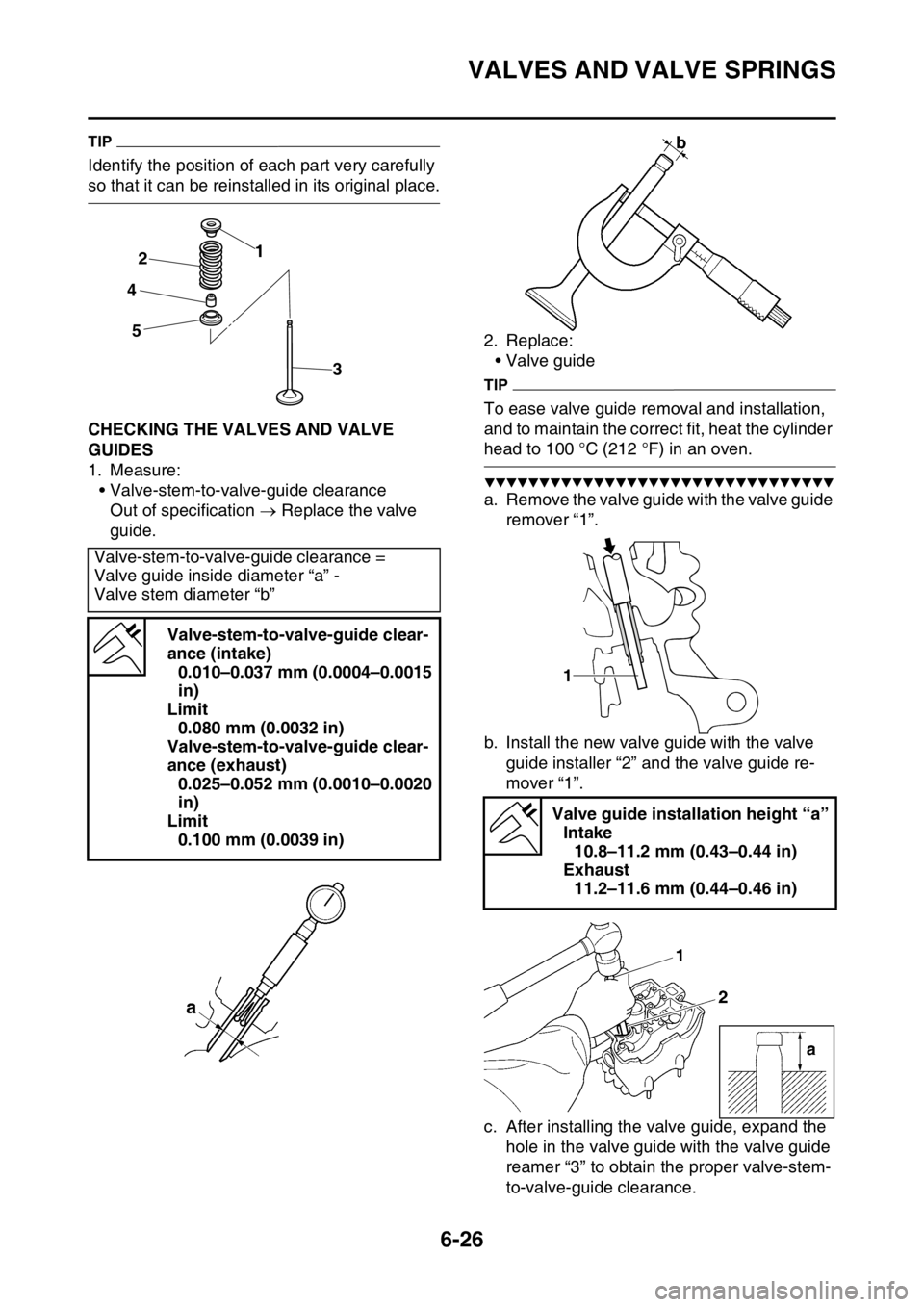
VALVES AND VALVE SPRINGS
6-26
TIP
Identify the position of each part very carefully
so that it can be reinstalled in its original place.
EAS2GBB251CHECKING THE VALVES AND VALVE
GUIDES
1. Measure:
• Valve-stem-to-valve-guide clearance
Out of specification Replace the valve
guide.2. Replace:
• Valve guide
TIP
To ease valve guide removal and installation,
and to maintain the correct fit, heat the cylinder
head to 100 °C (212 °F) in an oven.
▼▼▼▼▼▼▼▼▼▼▼▼▼▼▼▼▼▼▼▼▼▼▼▼▼▼▼▼▼▼▼▼
a. Remove the valve guide with the valve guide
remover “1”.
b. Install the new valve guide with the valve
guide installer “2” and the valve guide re-
mover “1”.
c. After installing the valve guide, expand the
hole in the valve guide with the valve guide
reamer “3” to obtain the proper valve-stem-
to-valve-guide clearance. Valve-stem-to-valve-guide clearance =
Valve guide inside diameter “a” -
Valve stem diameter “b”
Valve-stem-to-valve-guide clear-
ance (intake)
0.010–0.037 mm (0.0004–0.0015
in)
Limit
0.080 mm (0.0032 in)
Valve-stem-to-valve-guide clear-
ance (exhaust)
0.025–0.052 mm (0.0010–0.0020
in)
Limit
0.100 mm (0.0039 in)
1
2
4
5
3
Valve guide installation height “a”
Intake
10.8–11.2 mm (0.43–0.44 in)
Exhaust
11.2–11.6 mm (0.44–0.46 in)
1
Page 256 of 432
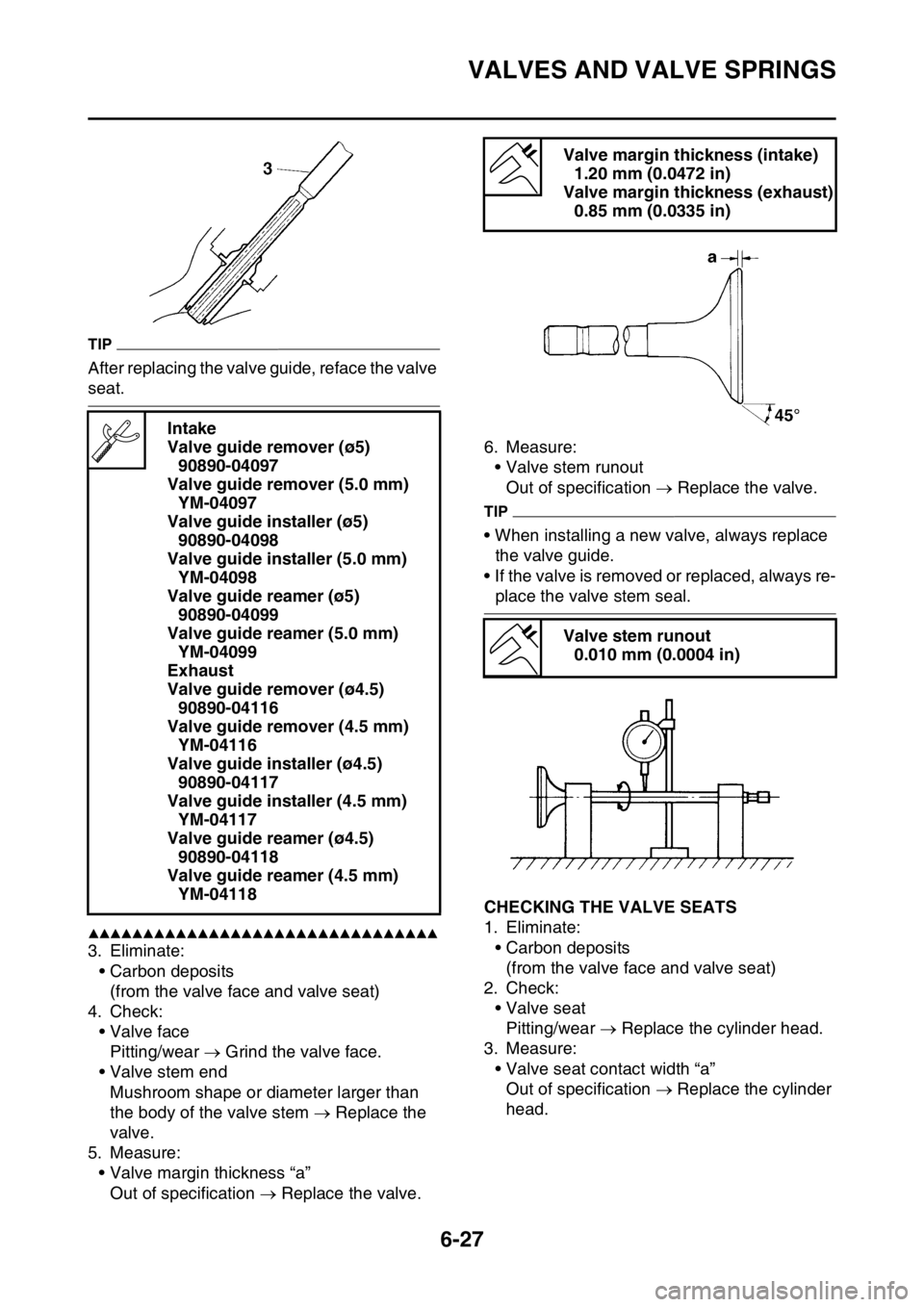
VALVES AND VALVE SPRINGS
6-27
TIP
After replacing the valve guide, reface the valve
seat.
▲▲▲▲▲▲▲▲▲▲▲▲▲▲▲▲▲▲▲▲▲▲▲▲▲▲▲▲▲▲▲▲
3. Eliminate:
• Carbon deposits
(from the valve face and valve seat)
4. Check:
• Valve face
Pitting/wear Grind the valve face.
• Valve stem end
Mushroom shape or diameter larger than
the body of the valve stem Replace the
valve.
5. Measure:
• Valve margin thickness “a”
Out of specification Replace the valve.6. Measure:
• Valve stem runout
Out of specification Replace the valve.
TIP
• When installing a new valve, always replace
the valve guide.
• If the valve is removed or replaced, always re-
place the valve stem seal.
EAS2GBB252CHECKING THE VALVE SEATS
1. Eliminate:
• Carbon deposits
(from the valve face and valve seat)
2. Check:
• Valve seat
Pitting/wear Replace the cylinder head.
3. Measure:
• Valve seat contact width “a”
Out of specification Replace the cylinder
head. Intake
Valve guide remover (ø5)
90890-04097
Valve guide remover (5.0 mm)
YM-04097
Valve guide installer (ø5)
90890-04098
Valve guide installer (5.0 mm)
YM-04098
Valve guide reamer (ø5)
90890-04099
Valve guide reamer (5.0 mm)
YM-04099
Exhaust
Valve guide remover (ø4.5)
90890-04116
Valve guide remover (4.5 mm)
YM-04116
Valve guide installer (ø4.5)
90890-04117
Valve guide installer (4.5 mm)
YM-04117
Valve guide reamer (ø4.5)
90890-04118
Valve guide reamer (4.5 mm)
YM-04118
Valve margin thickness (intake)
1.20 mm (0.0472 in)
Valve margin thickness (exhaust)
0.85 mm (0.0335 in)
Valve stem runout
0.010 mm (0.0004 in)
Page 257 of 432
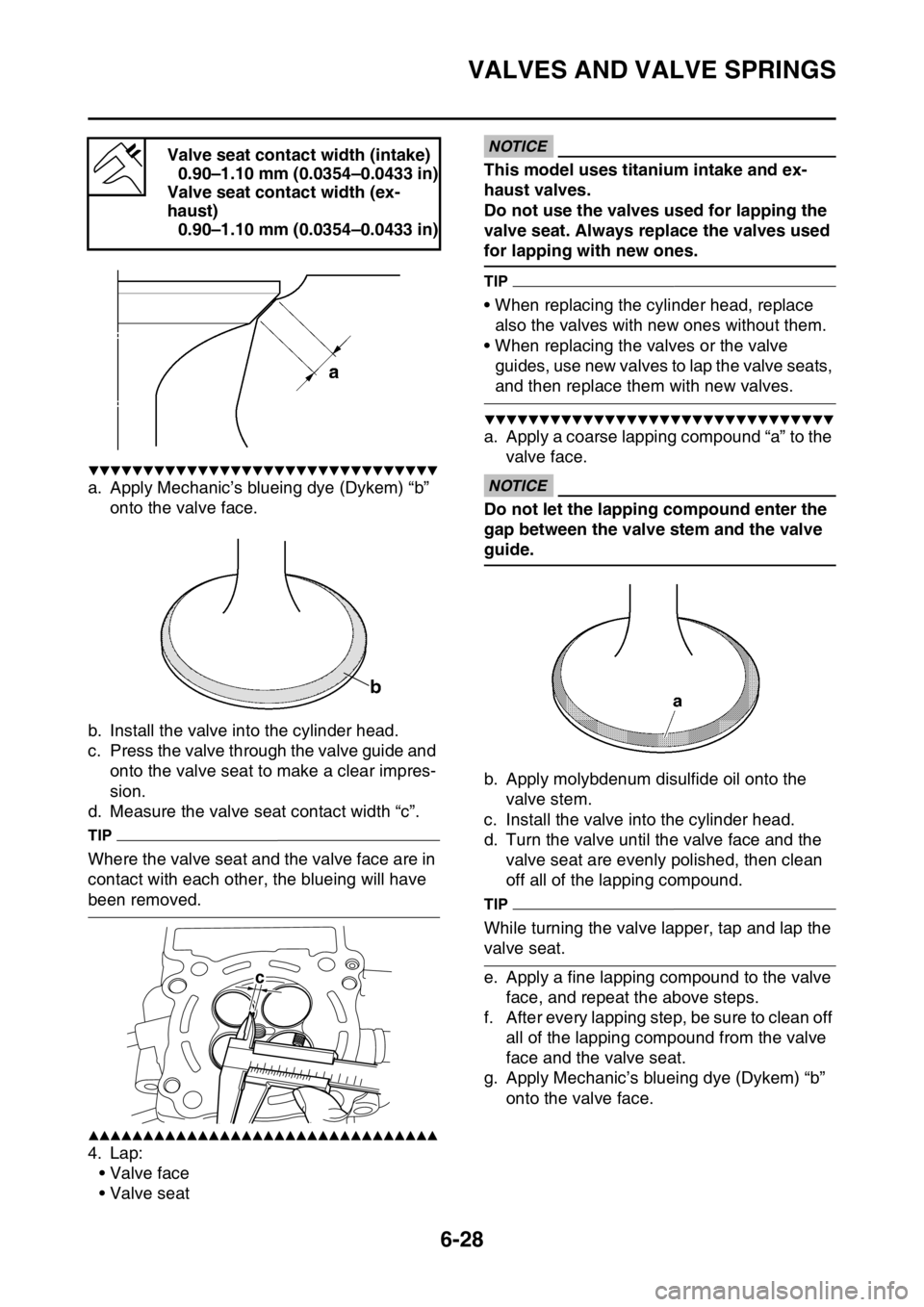
VALVES AND VALVE SPRINGS
6-28
▼▼▼▼▼▼▼▼▼▼▼▼▼▼▼▼▼▼▼▼▼▼▼▼▼▼▼▼▼▼▼▼
a. Apply Mechanic’s blueing dye (Dykem) “b”
onto the valve face.
b. Install the valve into the cylinder head.
c. Press the valve through the valve guide and
onto the valve seat to make a clear impres-
sion.
d. Measure the valve seat contact width “c”.
TIP
Where the valve seat and the valve face are in
contact with each other, the blueing will have
been removed.
▲▲▲▲▲▲▲▲▲▲▲▲▲▲▲▲▲▲▲▲▲▲▲▲▲▲▲▲▲▲▲▲
4. Lap:
• Valve face
• Valve seat
ECA
NOTICE
This model uses titanium intake and ex-
haust valves.
Do not use the valves used for lapping the
valve seat. Always replace the valves used
for lapping with new ones.
TIP
• When replacing the cylinder head, replace
also the valves with new ones without them.
• When replacing the valves or the valve
guides, use new valves to lap the valve seats,
and then replace them with new valves.
▼▼▼▼▼▼▼▼▼▼▼▼▼▼▼▼▼▼▼▼▼▼▼▼▼▼▼▼▼▼▼▼
a. Apply a coarse lapping compound “a” to the
valve face.
ECA
NOTICE
Do not let the lapping compound enter the
gap between the valve stem and the valve
guide.
b. Apply molybdenum disulfide oil onto the
valve stem.
c. Install the valve into the cylinder head.
d. Turn the valve until the valve face and the
valve seat are evenly polished, then clean
off all of the lapping compound.
TIP
While turning the valve lapper, tap and lap the
valve seat.
e. Apply a fine lapping compound to the valve
face, and repeat the above steps.
f. After every lapping step, be sure to clean off
all of the lapping compound from the valve
face and the valve seat.
g. Apply Mechanic’s blueing dye (Dykem) “b”
onto the valve face. Valve seat contact width (intake)
0.90–1.10 mm (0.0354–0.0433 in)
Valve seat contact width (ex-
haust)
0.90–1.10 mm (0.0354–0.0433 in)
c
Page 258 of 432
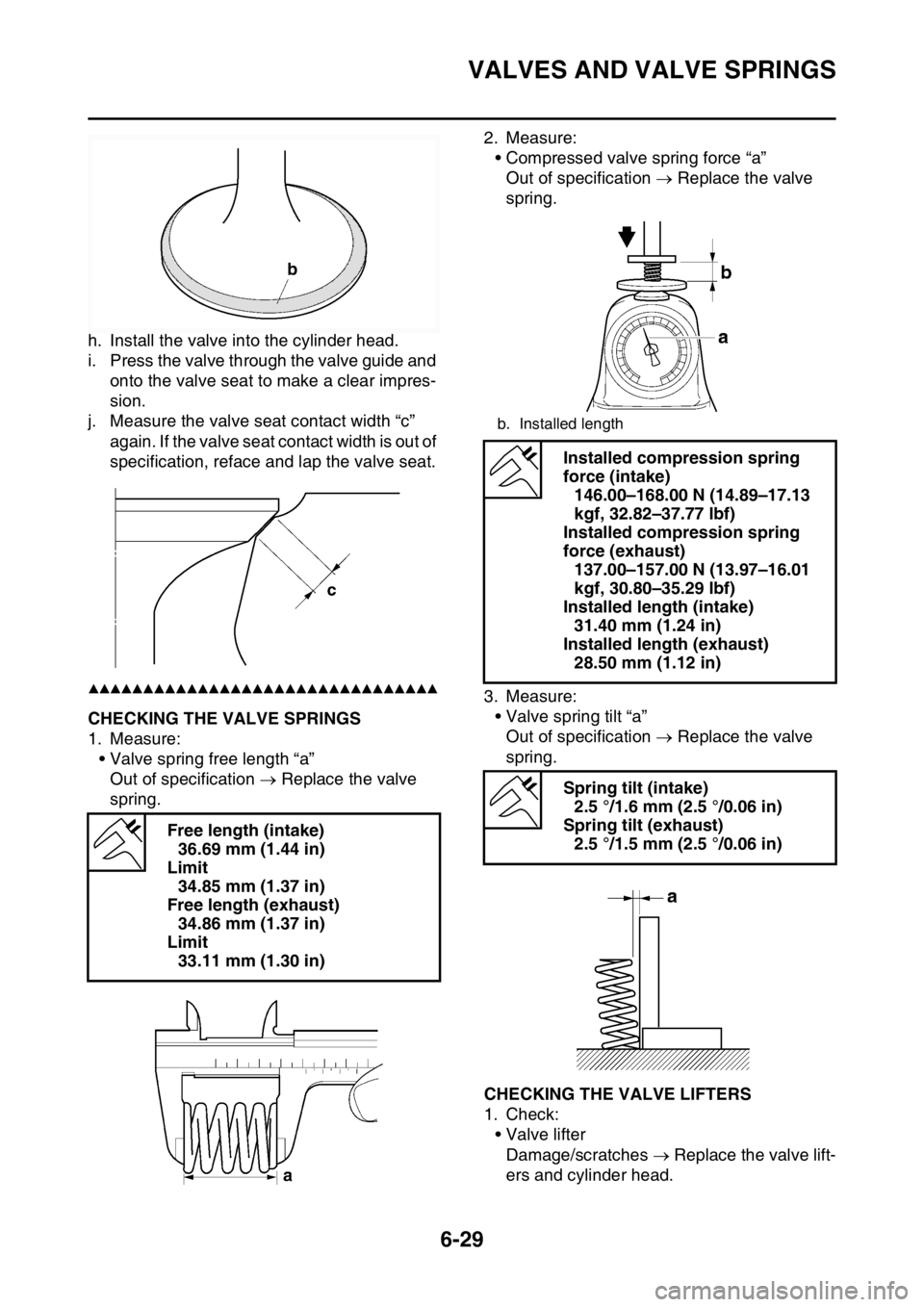
VALVES AND VALVE SPRINGS
6-29
h. Install the valve into the cylinder head.
i. Press the valve through the valve guide and
onto the valve seat to make a clear impres-
sion.
j. Measure the valve seat contact width “c”
again. If the valve seat contact width is out of
specification, reface and lap the valve seat.
▲▲▲▲▲▲▲▲▲▲▲▲▲▲▲▲▲▲▲▲▲▲▲▲▲▲▲▲▲▲▲▲
EAS2GBB253CHECKING THE VALVE SPRINGS
1. Measure:
• Valve spring free length “a”
Out of specification Replace the valve
spring.2. Measure:
• Compressed valve spring force “a”
Out of specification Replace the valve
spring.
3. Measure:
• Valve spring tilt “a”
Out of specification Replace the valve
spring.
EAS2GBB254CHECKING THE VALVE LIFTERS
1. Check:
• Valve lifter
Damage/scratches Replace the valve lift-
ers and cylinder head. Free length (intake)
36.69 mm (1.44 in)
Limit
34.85 mm (1.37 in)
Free length (exhaust)
34.86 mm (1.37 in)
Limit
33.11 mm (1.30 in)
b. Installed length
Installed compression spring
force (intake)
146.00–168.00 N (14.89–17.13
kgf, 32.82–37.77 lbf)
Installed compression spring
force (exhaust)
137.00–157.00 N (13.97–16.01
kgf, 30.80–35.29 lbf)
Installed length (intake)
31.40 mm (1.24 in)
Installed length (exhaust)
28.50 mm (1.12 in)
Spring tilt (intake)
2.5 °/1.6 mm (2.5 °/0.06 in)
Spring tilt (exhaust)
2.5 °/1.5 mm (2.5 °/0.06 in)
Page 259 of 432
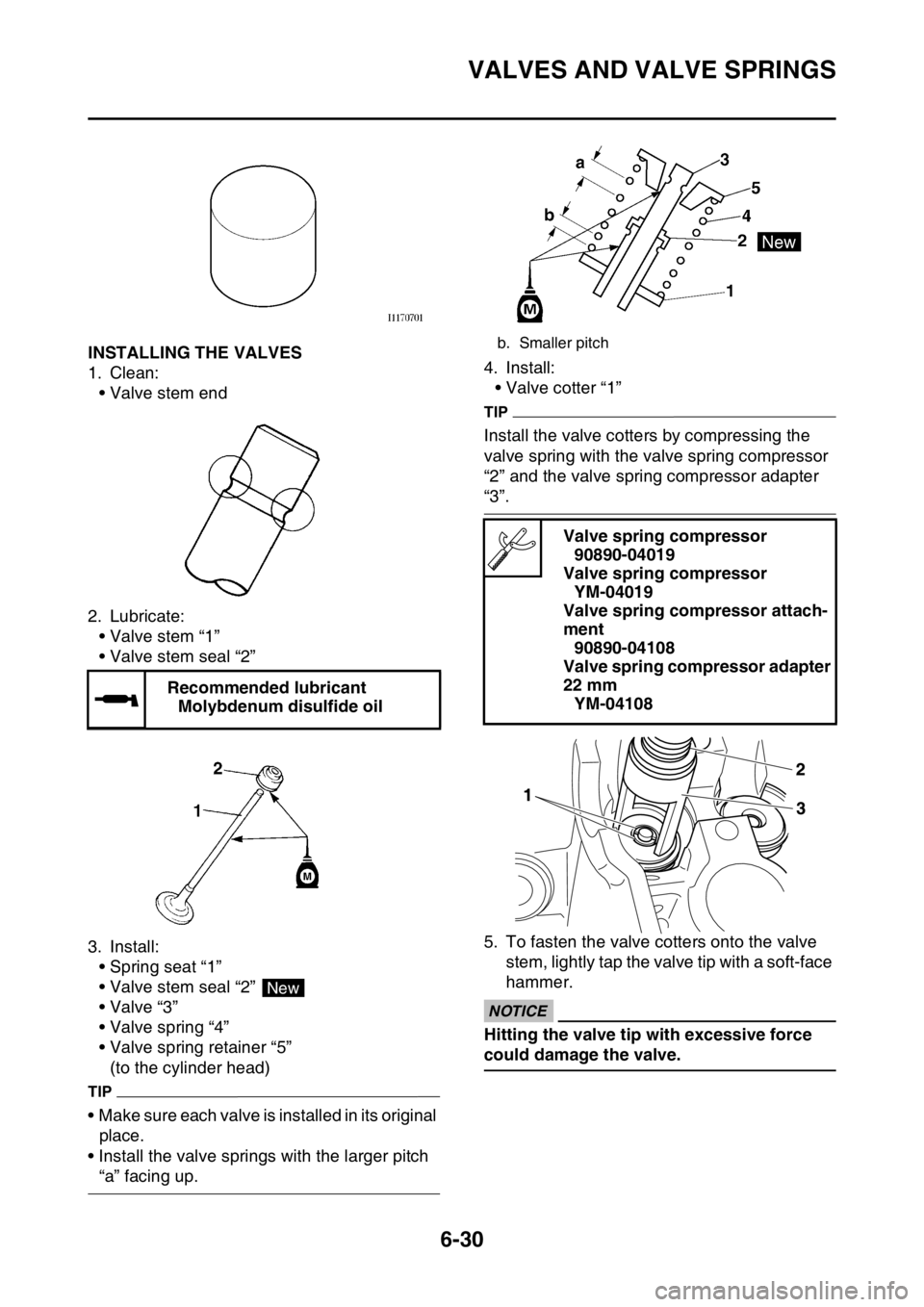
VALVES AND VALVE SPRINGS
6-30
EAS2GBB255INSTALLING THE VALVES
1. Clean:
• Valve stem end
2. Lubricate:
• Valve stem “1”
• Valve stem seal “2”
3. Install:
• Spring seat “1”
• Valve stem seal “2”
•Valve “3”
• Valve spring “4”
• Valve spring retainer “5”
(to the cylinder head)
TIP
• Make sure each valve is installed in its original
place.
• Install the valve springs with the larger pitch
“a” facing up.4. Install:
• Valve cotter “1”
TIP
Install the valve cotters by compressing the
valve spring with the valve spring compressor
“2” and the valve spring compressor adapter
“3”.
5. To fasten the valve cotters onto the valve
stem, lightly tap the valve tip with a soft-face
hammer.
ECA
NOTICE
Hitting the valve tip with excessive force
could damage the valve. Recommended lubricant
Molybdenum disulfide oil
New
b. Smaller pitch
Valve spring compressor
90890-04019
Valve spring compressor
YM-04019
Valve spring compressor attach-
ment
90890-04108
Valve spring compressor adapter
22 mm
YM-04108
Page 260 of 432
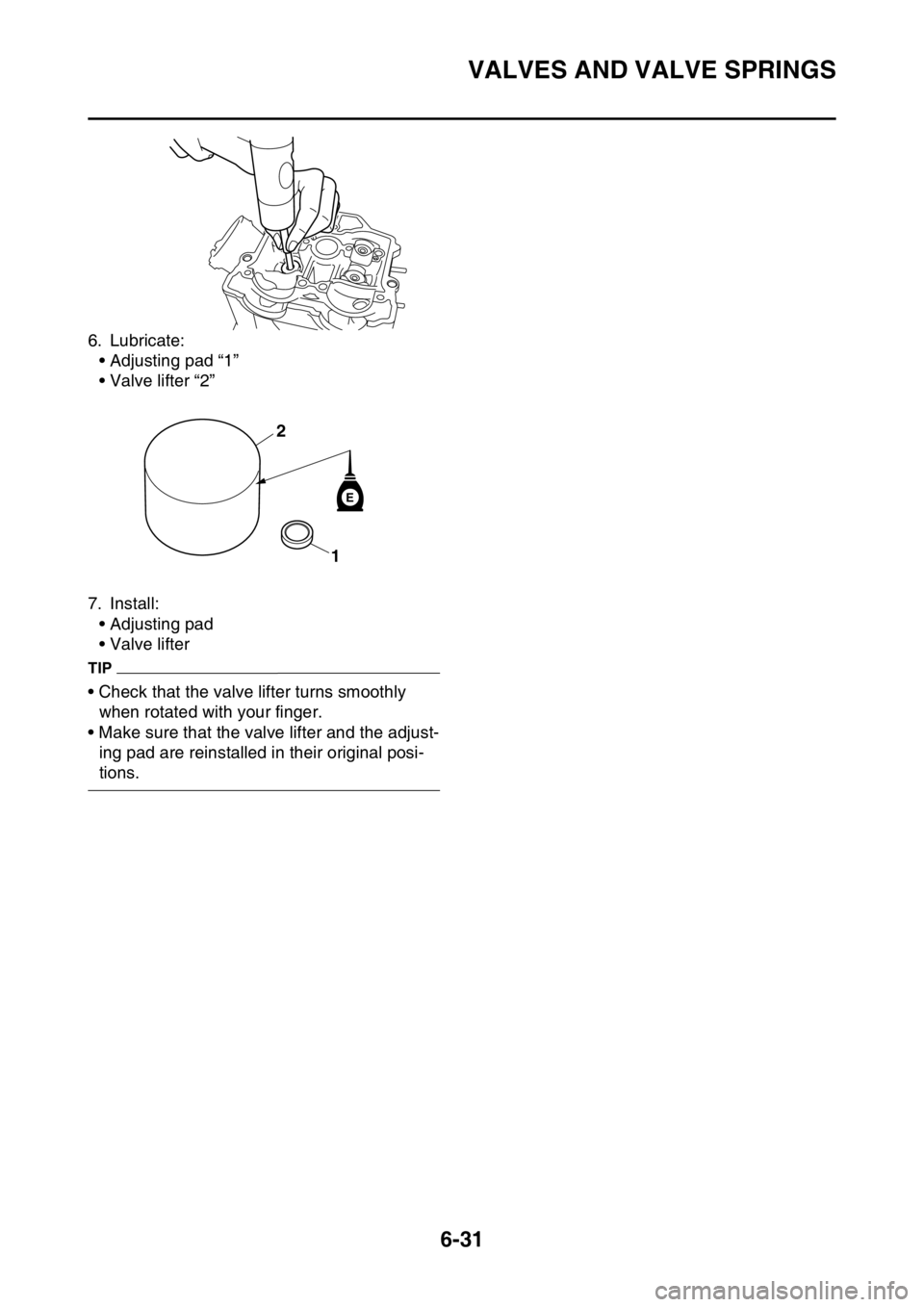
VALVES AND VALVE SPRINGS
6-31
6. Lubricate:
• Adjusting pad “1”
• Valve lifter “2”
7. Install:
• Adjusting pad
• Valve lifter
TIP
• Check that the valve lifter turns smoothly
when rotated with your finger.
• Make sure that the valve lifter and the adjust-
ing pad are reinstalled in their original posi-
tions.
E
1 2